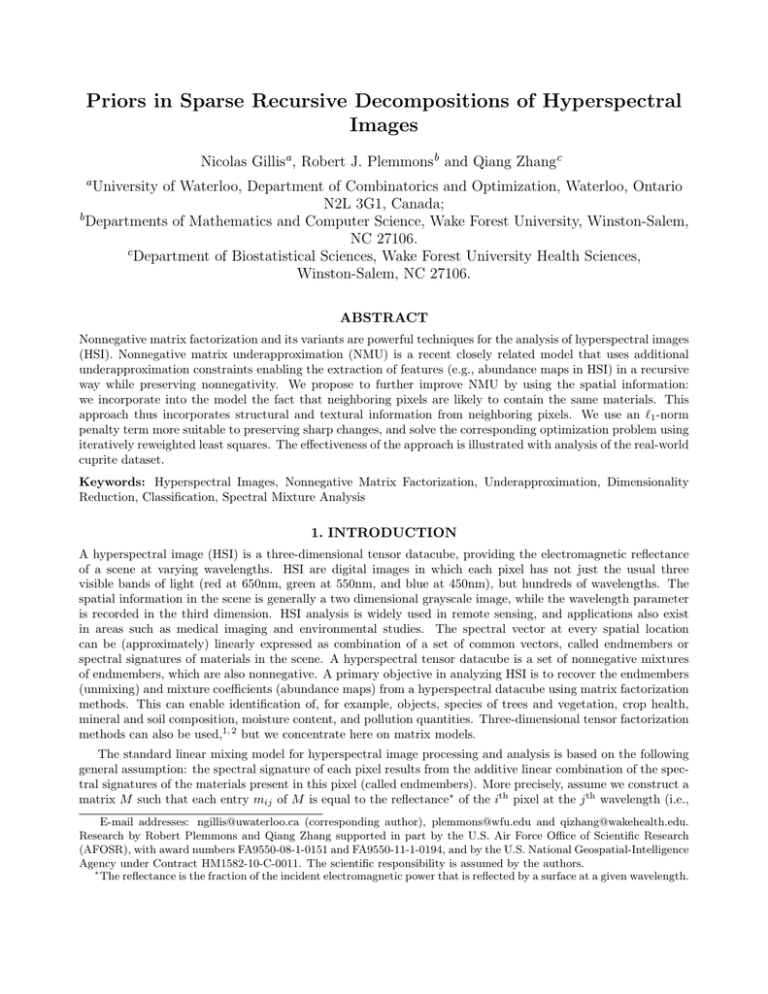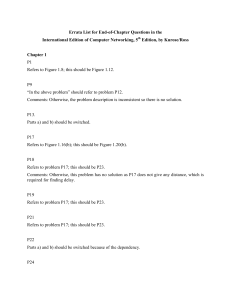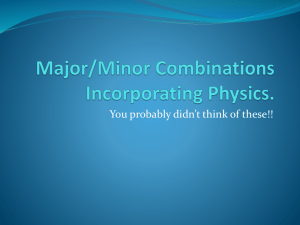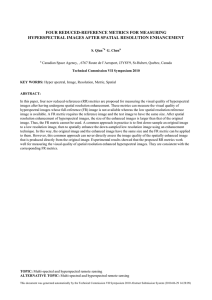Priors in Sparse Recursive Decompositions of Hyperspectral Images
advertisement

Priors in Sparse Recursive Decompositions of Hyperspectral
Images
Nicolas Gillisa , Robert J. Plemmonsb and Qiang Zhangc
a University
of Waterloo, Department of Combinatorics and Optimization, Waterloo, Ontario
N2L 3G1, Canada;
b Departments of Mathematics and Computer Science, Wake Forest University, Winston-Salem,
NC 27106.
c Department of Biostatistical Sciences, Wake Forest University Health Sciences,
Winston-Salem, NC 27106.
ABSTRACT
Nonnegative matrix factorization and its variants are powerful techniques for the analysis of hyperspectral images
(HSI). Nonnegative matrix underapproximation (NMU) is a recent closely related model that uses additional
underapproximation constraints enabling the extraction of features (e.g., abundance maps in HSI) in a recursive
way while preserving nonnegativity. We propose to further improve NMU by using the spatial information:
we incorporate into the model the fact that neighboring pixels are likely to contain the same materials. This
approach thus incorporates structural and textural information from neighboring pixels. We use an `1 -norm
penalty term more suitable to preserving sharp changes, and solve the corresponding optimization problem using
iteratively reweighted least squares. The effectiveness of the approach is illustrated with analysis of the real-world
cuprite dataset.
Keywords: Hyperspectral Images, Nonnegative Matrix Factorization, Underapproximation, Dimensionality
Reduction, Classification, Spectral Mixture Analysis
1. INTRODUCTION
A hyperspectral image (HSI) is a three-dimensional tensor datacube, providing the electromagnetic reflectance
of a scene at varying wavelengths. HSI are digital images in which each pixel has not just the usual three
visible bands of light (red at 650nm, green at 550nm, and blue at 450nm), but hundreds of wavelengths. The
spatial information in the scene is generally a two dimensional grayscale image, while the wavelength parameter
is recorded in the third dimension. HSI analysis is widely used in remote sensing, and applications also exist
in areas such as medical imaging and environmental studies. The spectral vector at every spatial location
can be (approximately) linearly expressed as combination of a set of common vectors, called endmembers or
spectral signatures of materials in the scene. A hyperspectral tensor datacube is a set of nonnegative mixtures
of endmembers, which are also nonnegative. A primary objective in analyzing HSI is to recover the endmembers
(unmixing) and mixture coefficients (abundance maps) from a hyperspectral datacube using matrix factorization
methods. This can enable identification of, for example, objects, species of trees and vegetation, crop health,
mineral and soil composition, moisture content, and pollution quantities. Three-dimensional tensor factorization
methods can also be used,1, 2 but we concentrate here on matrix models.
The standard linear mixing model for hyperspectral image processing and analysis is based on the following
general assumption: the spectral signature of each pixel results from the additive linear combination of the spectral signatures of the materials present in this pixel (called endmembers). More precisely, assume we construct a
matrix M such that each entry mij of M is equal to the reflectance∗ of the ith pixel at the j th wavelength (i.e.,
E-mail addresses: ngillis@uwaterloo.ca (corresponding author), plemmons@wfu.edu and qizhang@wakehealth.edu.
Research by Robert Plemmons and Qiang Zhang supported in part by the U.S. Air Force Office of Scientific Research
(AFOSR), with award numbers FA9550-08-1-0151 and FA9550-11-1-0194, and by the U.S. National Geospatial-Intelligence
Agency under Contract HM1582-10-C-0011. The scientific responsibility is assumed by the authors.
∗
The reflectance is the fraction of the incident electromagnetic power that is reflected by a surface at a given wavelength.
each row mTi of M corresponds to the spectral signature of a pixel and each column mj of M to an image at a
given wavelength), then the model reads
Mi: ≈
r
X
Uik Vk:
∀i,
k=1
where r is the number of materials present in the hyperspectral image. In fact, the spectral signature of each
pixel (Mi: , a row of M ) is approximated by a nonnegative linear combination (with weights Uik ≥ 0, representing
abundances) of endmembers’ signatures (Vk: ≥ 0) approximating the true signatures of the constituent materials
of the hyperspectral image. This corresponds exactly to the nonnegative matrix factorization (NMF) model:
given M ∈ Rm×n
and an integer r ≤ min(m, n), solve
+
min
U ∈Rm×r ,V ∈Rr×n
kM − U V k2F
such that U ≥ 0 and V ≥ 0.
(1.1)
However, NMF is typically not able to separate all end-members correctly because of the non-uniqueness of
the solution.3 In order to improve NMF performances for hyperspectral image analysis, one should incorporate
prior information into the model, and take into account the characteristics of the solutions to make the problem
more well-posed, e.g., sparsity of the abundance matrix and piecewise smoothness of the spectral signatures,4
orthogonality,5 minimum-volume,6 and sum-to-one constraints on the abundances.7
Nonnegative matrix underapproximation (NMU)8 is a recent closely related model that uses additional underapproximation constraints enabling the recursive extraction of abundance maps in HSI. At the first step,
NMU requires solving the following optimization problem
min kM − xy T k2F
x≥0,y≥0
such that xy T ≤ M,
(1.2)
where M ∈ Rm×n is the given nonnegative data matrix. Then, the residual matrix R = M −xy T ≥ 0 is computed
and the same procedure is applied on R. After r steps, we obtain an approximate NMF solution of rank r. NMU
has several advantages over NMF:
1. It is well-posed (the solution is, under some mild assumption, unique9 ).
2. The factorization rank does not have to be chosen a priori.
3. It produces sparser solution leading to a better decomposition into parts.8
Moreover, it was theoretically and experimentally shown to be able to extract automatically constitutive materials
in HSI.9–11 However, sometimes, NMU fails at extracting all endmembers and mixes some of them. A possible
way to improve NMU performances is to add prior information into the model. It was shown12 how adding
sparsity constraint on the abundance matrix makes it able to extract endmembers in a more efficient way.
In this paper, we propose to add spatial information into NMU, i.e., we incorporate in the model the fact
that neighbor pixels are likely to contain the same materials, and can thus incorporate structural and textural
information from neighboring pixels. We refer to this method as spatial NMU, and apply the technique on the
cuprite dataset and show that it performs better than NMU, and competes favorably with the popular Vertex
Component Analysis (VCA) method.13
2. SPATIAL NONNEGATIVE MATRIX UNDERAPPROXIMATION
The objective of this section is to design an algorithm to solve NMU problem (1.2) while taking the local
information into account. The typical approach is to add a regularization term into the objective function. We
propose here to use the following
m
X
X
|xi − xj |,
i=1 j∈N (i)
where N (i) is the set of neighboring pixels of pixel i. The `1 -norm is suitable for image analysis because it is
able to preserve the edges (using the `2 -norm would smooth them out), see14, 15 and the references therein where
the same penalty term is used for HSI.
Let us construct the ‘neighbor’ matrix N as follows. Each pair (i, j) of neighboring pixels with 1 ≤ i < j ≤ m,
i ∈ N (j) and j ∈ N (i) corresponds to a row (say at position k) of matrix N ∈ RK×m with
N (k, i) = 1 and N (k, j) = −1,
so that
m
X
X
(2.1)
|xi − xj | = 2kN xk1 .
i=1 j∈N (i)
Notice that K, the number of neighboring pairs, is proportional to the number of pixels in the image. In this
paper, we define the neighboring pixels as the adjacent pixels (hence each pixel has at most four neighbors and
K ≤ 4m).
2.1 Lagrangian Dual
In Ref.,8 approximate solutions of NMU (1.2) are obtained by solving the Lagrangian dual
X
max min L(x, y, Λ) = kM − xy T k2F + 2
(xy T − M )ij Λij ,
Λ≥0 x≥0,y≥0
(2.2)
i,j
where Λ ∈ Rm×n
is the matrix containing the Lagrangian multipliers. This is achieved by applying the following
+
alternating scheme
.
1. x ← argminx̄≥0 L(x̄, y, Λ) = max 0, (My−Λ)y
Ty
T
x
.
2. y ← argminȳ≥0 L(x, ȳ, Λ) = max 0, (Mx−Λ)
Tx
3. Λ ← max(0, Λ + αk (xy T − M )), where αk is a square summable but not summable sequence (e.g., αk = k1 ),
as used in online algorithms.16 This is projected gradient step since ∇Λ L(x̄, y, Λ) = 2(xy T − M ).
In order to increase the spatial coherence, we are going to modify the update of x to take into account the
regularization term kN xk1 .
Equivalent Lagrangian Relaxation
For a fixed Λ, the problem, minx≥0,y≥0 L(x, y, Λ), is called a Lagrangian relaxation of (1.2). Let us introduce
a variable σ ≥ 0 and fix the norms of x and y to one to obtain the following equivalent problem
min
σ≥0,x≥0,y≥0
−2σxT (M − Λ)y + σ 2 kxy T k2F , such that kxk2 = kyk2 = 1.
| {z }
(2.3)
=1
For any fixed (x, y), the minimum of (2.3) is achieved at σ ∗ (x, y) = max(0, xT (M −Λ)y). Assuming xT (M −Λ)y ≥
0 (otherwise σ is equal to zero and we have a trivial solution), (2.3) is equivalent to
max xT (M − Λ)y, such that kxk2 = kyk2 = 1.
x≥0,y≥0
(2.4)
In order to improve the spatial coherence in x, we add the regularization term described in the previous section
and, for a fixed y, our goal is to solve
max
x≥0,kxk2 =1
xT (M − Λ)y −
µ
kN xk1 .
2
In the following, we use iteratively re-weighted least squares and a simple gradient scheme to find an approximate
solution to this subproblem.
2.2 Iteratively Re-Weighted Least Squares (IRWLS)
Consider problems of the type
µ
kN xk1 ,
(2.5)
2
and assume for now that the optimal objective function value is positive (see Section 2.3 for a discussion). Then
we can replace the constraint kxk2 = 1 with kxk2 ≤ 1 (in fact, the constraint will be active at optimality since
multiplying x by a constant factor multiplies the objective function by the same factor). Unfortunately, the
term kN xk1 is non-differentiable and computationally difficult to work with. In this paper, we propose to use
iteratively re-weighted least squares (IRWLS):17 assuming the vector z is positive, we have that
X
X z2
2
i
= kw ◦ zk2 ,
kzk1 =
|zi | =
|z
|
i
i
i
max
xT Ay −
x≥0,kxk2 =1
where wi = √1 , ∀i, and ‘◦’ is the component-wise product. IRWLS fixes the weight w based on the value of
|zi |
z at the previous iteration. Denote z (k) as z at the k th iteration. Then kzk1 is approximated at the (k + 1)th
(k)
(k)
2
iteration with kzkw(k) , where wi = (|zi | + )−0.5 for a small positive constant . In (2.5), kN xk1 is then
replaced at the (k + 1)th iteration with
T
kN xk1 ≈ kw(k) ◦ (N x)k22 = kW (k) N xk22 = xT (N T W (k) W (k) N )x,
(k)
where wi = (|N x(k) |i + )−1/2 ∀i, x(k) is the k th iterate, and W (k) = diag(w(k) ) (i.e., W (k) is a diagonal matrix
whose diagonal entries are given by the entries of w(k) ). Hence the subproblem (2.5) is now a convex quadratic
program:
µ
max
f (x) = xT Ay − xT Bx,
(2.6)
2
x≥0,kxk2 ≤1
T
where B = N T W (k) W (k) N 0 at the (k + 1)th iteration. For this preliminary work, we propose to solve
problem (2.6) with a simple projected gradient scheme18 which guarantees the objective function to decrease:
1
x ← P x + ∇f (x) , ∇f (x) = Ay − µBx,
L
where L is the Lipschitz constant of ∇f (x) (which is equal to the largest eigenvalue of B), and P is the projection
onto the set {x ∈ Rm | x ≥ 0, kxk2 ≤ 1}, given by
( max(z,0)
if k max(z, 0)k2 > 1,
k max(z,0)k2
P(z) =
max(z, 0)
otherwise.
Since B is a very large (but sparse) K-by-K matrix, it is computational costly to compute exactly its largest
eigenvalue. Instead, since B is sparse, we propose to use several steps of the power method (see step 12 of
Algorithm 1). Notice that the power method underestimates the Lipschitz constant, which allows the algorithm
to initially take larger steps. In the worst-case, this scheme requires O( L ) iterations, where is the desired
accuracy
q for the objective function. In further work, we plan to use a fast gradient method requiring only
O
L
iterations.18
Remark 1. We have also implemented a subgradient method to solve (2.5) similarly as in Ref.,14 but convergence
was much slower and the step length strategy is much more difficult to handle.
Remark 2. Because the `1 -norm penalty term kN xk1 is a regularization term and since the ultimate goal is
to increase the spatial coherence in the solution, the fact that |kN xk1 is somehow loosely approximated is not
crucial, while it makes the subproblems much more easily solvable.
Finally, Algorithm 1 gives the pseudocode for the proposed alternating scheme for increasing the spatial
coherence in NMU solutions: Λ and y are updated similarly as in the original NMU algorithm while x is updated
as described above by taking into account the `1 -norm penalty term. We initialize (x, y, Λ) with an approximate
solution of (2.2) using the algorithm from Ref.9 The code is available at https://sites.google.com/site/
nicolasgillis/.
Algorithm 1 NMU incorporating spatial information
Require: M ∈ Rm×n
, r > 0, maxiter, λ ≥ 0, > 0, iter.
+
Ensure: (U, V ) ∈ Rm×r
× Rn×r
s.t. U V T . M .
+
+
1: Generate the matrix N ; % see Equation (2.1)
2: for k = 1 : r do
3:
z = rand(); % Estimate of the eigenvector of B associated with the largest eigenvalue
4:
% Intialization of (x, y) with an approximate solution to NMU (1.2), see Ref.9
5:
[x, y, Λ] = rank-one underapproximation(M );
y
x
; y ← kyk
;
6:
uk ← x; vk ← y; x ← kxk
2
2
7:
8:
9:
10:
11:
12:
13:
14:
15:
16:
17:
18:
19:
20:
21:
22:
23:
24:
−0.5
wi = (|N x|i + )
; W = diag(w); % Initialization of IRWLS weights
for p = 1 : maxiter do
A = M − Λ;
% Update of x
B = (W N )T (W N );
z
for l = 1 : iter, z = Bz; z = kzk
; end % Power method
2
T
L = z Bz; % Approximated Lipschitz constant
for l = 1 : iter do
kAyk∞
µ = λ kBxk
;
∞
∇f (x) = Ay − µBx;
x ← P x + L1 ∇f (x) ;
end for
% Update of y
y
y ← max 0, (M − Λ)T x ; if y 6= 0, y ← kyk
; endif
2
% Update of Λ and save (x, y)
if x 6= 0 and y 6= 0 then
σ = xT Ay; uk ← x; vk ← σy;
Λ ← max 0, Λ − p1 (M − uk vkT ) ;
% Update the IRWLS weights
−0.5
wi = (|N x|i + )
; W = diag(w);
25:
26:
27:
28:
else
Λ←
Λ
2;
x←
uk
kuk k2 ;
y←
vk
kvk k2 ;
29:
end if
30:
end for
31:
M = max(0, M − uk vkT );
32: end for
2.3 Heuristic for the Choice of the Penalty Parameter µ
In the previous section, we assumed that the optimal objective function value of problem (2.5) was nonnegative
so that the solution x is not forced to zero (which would lead to a trivial solution). If the current iterate x(k)
has norm one, then we ideally would like the next iterate P(x(k) + L1 ∇f (x(k) )) to have norm one as well, i.e.,
the gradient direction does not point towards zero. A necessary and sufficient (but rather strong) condition is
P
T
to require x(k) ∇f (x(k) ) ≥ 0 (in fact, the gradient of the constraints i x2i − 1 ≤ 0 is 2x) from which we would
T
T
have to take µ such that µx(k) Bx(k) ≤ x(k) Ay (k) . Based on this observation, we have tried different heuristics
and it seems that the following choice works best:
µ=λ
kAy (k) k∞
,
kBx(k) k∞
for some λ ∈ [0, 1].
In contrast, we observed that fixing the value of µ a priori is rather difficult and requires one to take different
values at each step of the NMU recursion. A value of λ between 0.1 and 0.5 seems to work well in practice (see
Section 3). A more detailed analysis and a better choice for the parameter µ are topics for further research.
3. NUMERICAL EXPERIMENTS - CUPRITE DATASET
We now apply NMU and spatial NMU on the cuprite dataset† . Cuprite is a mining area in southern Nevada
with mostly mineral and very little vegetation, located approximately 200km northwest of Las Vegas, see, e.g.,13
for more information and http://speclab.cr.usgs.gov/PAPERS.imspec.evol/aviris.evolution.html. It
consists of 188 images, each having 250 × 191 pixels, and is composed of about 20 different materials (minerals).
We use the following parameters for Algorithm 1: maxiter = 100, λ = 0.1, = 10−3 , and iter = 10. Figures 1
and 2 display the first 16 basis elements obtained with NMU and spatial NMU respectively, while Figure 3
displays other basis elements extracted by spatial NMU further in the recursion. Spatial NMU clearly generates
a better decomposition, being able to separate more materials and obtaining basis elements with less noise
and better spatial coherence. Moreover, spatial NMU preserves the edges of the constitutive materials. These
properties can be easily observed, for example, on the seventh basis elements obtained with NMU and spatial
NMU (Chalcedony).
Notice that some basis elements obtained with spatial NMU are still rather noisy; in particular the tenth and
twelfth basis elements. Increasing the penalty µ allows one to improve upon these results, see Figure 4, where
we used λ = 0.3 (instead of λ = 0.1) allowing the extracted materials to appear much more clearly.
Table 1 gives the materials present in the the basis elements extracted by spatial NMU. Some materials are
particularly well separated: Hematite (a2), Alunite (a3), Chalcedony (b3), Kaolinite (b4), Muscovite (c1 and
f2), Montmorillonite (c3), Alunite-K (d3) and Koalinite wxl (e4), while others remain mixed, e.g., jarosite (f1)
is mixed with some Hematite. (In future work, we plan to include both sparsity and spatial information which
will allow us to separate materials in a more efficient way.)
(1)
(2)
(3)
(a)
Mixture
Hematite
Alunite
(b)
Muscovite
Montmorillonite
(c)
Muscovite
Amorphous iron oxydes
Goethite
Hematite
Muscovite
Buddingtonite
Muscovite
Kaolinite #3
Nontronite
Muscovite
(d)
(e)
(f)
Alunite-K
Goethite
Hematite
Jarosite
(4)
Kaolinite #1
Goethite
Chalcedony
Kaolinite #1
Montmorillonite
Kaolinite #2
Alunite-K
Fine-grained Hematite
Nontronite
Buddingtonite
Kaolinite wxl
Desert Varnish
Table 1. Classification: materials present in the abundance maps generated by spatial NMU, see Figures 2 and 3.
Because of the recursive procedure in generating U and V by NMU, the factor V does not correspond directly
to the spectral signatures of the extracted materials, cf. the discussion in.12 Many approaches are possible to
obtain the spectral signatures from the abundance maps. We propose here a simple strategy: we take the
weighted average of the spectral signatures of the pixels present in the corresponding abundance map, i.e., for
the ith abundance map ui , we take
X
si =
uki mTk .
k
Figure 5 displays some of the spectral signatures hence obtained, compared with the spectral signatures from
the USGS library (http://speclab.cr.usgs.gov/spectral.lib06/) and the ones obtained with the Vertex
Component Analysis (VCA) algorithm.13 Spatial NMU performs similarly as VCA and is able to extract some
†
Available at http://aviris.jpl.nasa.gov/html/aviris.freedata.html.
materials that were not extracted by VCA (e.g., Chalcedony and Jarosite) and generate spatially more coherent
abundance maps (the ones obtained from the VCA spectral signatures are much more noisy and difficult to
interpret, see13 ).
4. CONCLUSIONS
In summary, we have extended the original nonnegative matrix underapproximation model by formulating the
spatial closeness of hyperspectral pixels using an l1 -norm regularization term. Thus the material constitutions
of neighboring pixels are constrained to be similar, which effectively reduces the noise often seen in abundance
maps produced by linear unmixing models. Since l1 -norm penalty terms are generally difficult to work with, we
relaxed it with iteratively re-weighted least squares to convert it into a convex quadratic program, which is then
solved with a projected gradient scheme. Experiments on the Cuprite dataset show comparatively better results,
especially in terms of the sharpness of abundance maps, and even shows extracted materials not obtained by the
VCA algorithm. Future work will include refinement of our spatial NMU algorithm and numerical evaluations
on additional hyperspectral datasets.
REFERENCES
[1] Zhang, Q., Wang, H., Plemmons, R., and Pauca, P., “Tensor methods for hyperspectral data analysis: a
space object material identification study,” J. Optical Soc. Amer. A 25 (12), 3001–3012 (2008).
[2] Zhang, L., Zhang, L., Tao, D., and Huang, X., “A multifeature tensor for remote sensing target recognition,”
IEEE Geoscience and Remote Sensing Letters 8 (2), 374–378 (2011).
[3] Laurberg, H., Christensen, M., Plumbley, M., Hansen, L., and Jensen, S., “Theorems on positive data: On
the uniqueness of NMF,” Comput. Intel. and Neurosci. 2008. ID 764206.
[4] Jia, S. and Qian, Y., “Constrained nonnegative matrix factorization for hyperspectral unmixing,” IEEE
Trans. on Geoscience and Remote Sensing 47(1), 161–173 (2009).
[5] Li, H., Adal, C., Wang, W., Emge, D., and Cichocki, A., “Non-negative matrix factorization with orthogonality constraints and its application to raman spectroscopy,” The Journal of VLSI Signal Processing 48,
83–97 (2007).
[6] Miao, L. and Qi, H., “Endmember extraction from highly mixed data using minimum volume constrained
nonnegative matrix factorization,” IEEE Trans. on Geoscience and Remote Sensing 45(3), 765–777 (2007).
[7] Masalmah, Y. and Vélez-Reyes, M., “A full algorithm to compute the constrained positive matrix factorization and its application in unsupervised unmixing of hyperspectral imagery,” in [Proc. SPIE, Vol. 6966;
doi:10.1117/12.779444 ], (2008).
[8] Gillis, N. and Glineur, F., “Using underapproximations for sparse nonnegative matrix factorization,” Pattern
Recognition 43(4), 1676–1687 (2010).
[9] Gillis, N. and Plemmons, R., “Dimensionality reduction, classification, and spectral mixture analysis using
nonnegative underapproximation,” Optical Engineering 50, 027001 (2011).
[10] Kopriva, I., Chen, X., and Jao, Y., “Nonlinear Band Expansion and Nonnegative Matrix Underapproximation for Unsupervised Segmentation of a Liver from a Multi-phase CT image,” in [SPIE Medical ImagingImage Processing Volume 7962, Orlando], (2011).
[11] Kopriva, I., Hadzija, M., Hadzija, M., Korolija, M., and Cichocki, A., “Rational variety mapping for
contrast-enhanced nonlinear unsupervised segmentation of multispectral images of unstained specimen,”
The American Journal of Pathology 179(2), 547–554 (2011).
[12] Gillis, N. and Plemmons, R., “Sparse nonnegative matrix underapproximation and its application to hyperspectral image analysis,” in [Third Worskshop on Hyperspectral Image and Signal Processing: Evolution in
Remote Sensing (WHISPERS), Lisbon ], (2011).
[13] Nascimento, J. and Dias, J., “Vertex component analysis: a fast algorithm to unmix hyperspectral data,”
IEEE Transactions on Geoscience and Remote Sensing 43(4), 898–910 (2005).
[14] Zymnis, A., Kim, S.-J., Skaf, J., Parente, M., and Boyd, S., “Hyperspectral image unmixing via alternating
projected subgradients,” in [Signals, Systems and Computers, 2007], 1164 –1168 (2007).
[15] Iordache, M.-D., Bioucas-Dias, J., and Plaza, A., “Total variation regulatization in sparse hyperspectral
unmixing,” in [Third Worskshop on Hyperspectral Image and Signal Processing: Evolution in Remote Sensing
(WHISPERS), Lisbon], (2011).
[16] Bottou, L., [Online algorithms and stochastic approximations], Online Learning and Neural Networks, David
Saad, Ed. Cambridge University Press, Cambridge, UK (1998).
[17] Daubechies, I., DeVore, R., Fornasier, M., and Gunturk, C., “Iteratively reweighted least squares minimization for sparse recovery,” Communications on Pure and Applied Mathematics 63(1), 1–38 (2010).
[18] Nesterov, Y., [Introductory lectures on convex optimization: a basic course], Kluwer, Boston (2004).
Figure 1. First 16 abundance maps extracted by NMU. (Light tones indicate a high degree of membership.)
Figure 2. First 16 abundance maps extracted by spatial NMU (λ = 0.1), see Table 1 for the classification. (Light tones
indicate a high degree of membership.)
Figure 3. Other abundance maps extracted by Spatial NMU (λ = 0.1), see Table 1 for the classification. (Light tones
indicate a high degree of membership.)
Figure 4. (i) Tenth basis element obtained with spatial NMU for λ = 0.1, and (ii) for λ = 0.3.
element obtained with spatial NMU for λ = 0.1, and (iv) for λ = 0.3.
(iii) Twelfth basis
Figure 5. Spectral signatures from the USGS library (continuous black curves), spectral signatures obtained with spatial
NMU (dashed-dotted red curves), and with VCA (dashed blue curves).






